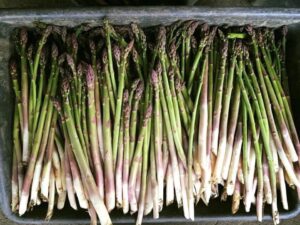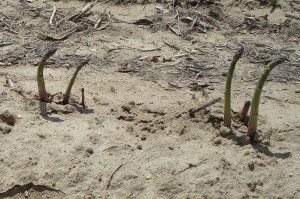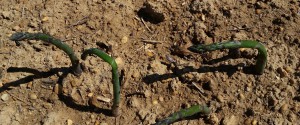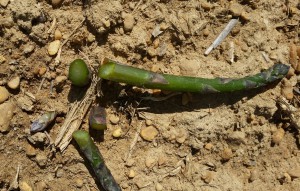Asparagus growers should consider scouting their fields during the summer months for foliar disease development. Important pathogens that growers need to scout for on a regular basis include Purple spot, Cercospora, and Rust. [Read more…]
Register for a Free Asparagus Webinar – March 17th 10:00AM

Penn State announced an upcoming free Zoom Meeting on Asparagus Production, Management, and Marketing. The presentation will be given by Carl Cantaluppi, Retired Area Extension Agent, North Carolina Cooperative Extension. Registration required to obtain Zoom link.
The Meeting will be on Wednesday, March 17 from 10 A.M. to 12 Noon. It will be free and open to all that are interested. The publication entitled, “Growing Asparagus from A to Z” will be available for sale but is not required to attend the meeting.
Click on the link below to register for the meeting:
https://nam02.safelinks.protection.outlook.com/?url=https%3A%2F%2Fextension.psu.edu%2Fasparagus-production-management-and-marketing&data=04%7C01%7Cminfante%40njaes.rutgers.edu%7C6c4ad96b99884d60da8308d8d424f5e0%7Cb92d2b234d35447093ff69aca6632ffe%7C1%7C0%7C637492602501485088%7CUnknown%7CTWFpbGZsb3d8eyJWIjoiMC4wLjAwMDAiLCJQIjoiV2luMzIiLCJBTiI6Ik1haWwiLCJXVCI6Mn0%3D%7C1000&sdata=dwjiC0F1OFulJPA2AXvCRZEzpwmxht7JYQWtnGHnsNk%3D&reserved=0
Spear Damage in Asparagus
Spear damage in asparagus can be caused by diseases such as Phytophthora spear and crown rot and purple spot. However, other environmental factors during the spring can damage spears as they emerge from the soil.
| Freeze Injury – About 10 days ago temperatures dipped well below freezing for a night or two, and combined with the higher than normal temperature this spring, some asparagus fields that had already started to produce spears were hit with injury. Affected spears will be bent/distorted and begin to breakdown and rot (Fig. 1a).
Cutting frozen spears will show the discoloration of the spear caused by the freeze (Fig. 1b). |
 Fig. 2. Wind damage of asparagus spears. Notice how all spears are pointed in the same direction |
Wind – Periods of heavy winds during emergence will cause spears to bend.Winds can cause one side of the spear to dry out quicker than the other causing the spear to bend and point in the direction of the prevailing wind. An asparagus planting is suffering from wind damage if most of the bent spear heads in the bed are pointing in the same direction (Fig.2). |
Vegetable Disease Update – 4/4/20
Warmer days and cool nights, along with cool soils and the regular wet weather has made conditions ideal for disease development in some spring crops. Growers should consider applying preventative fungicide applications for early-season diseases, particularly root rots, either in the transplant water or shortly after transplanting or seeding to help mitigate potential issues. All fields should be scouted on a regular basis. White rust and anthracnose were reported on spinach this week, so leaf spot pathogens are already active.
[Read more…]
Controlling Spring Diseases in Asparagus
Asparagus season is just around the corner and now is a good time to review important diseases.
Wet soil conditions are ideal for Phytophthora and Pythium development. To help reduce potential losses, especially in fields with low spots or fields that are poorly drained soils, or more importantly, in fields with a history of either disease apply Orondis Gold (oxathiapiprolin + mefenoxam (FRAC groups 49 + 4) at 4.8 to 9.6 fl oz/A, Ridomil Gold 4SL (mefenoxam, 4) at 1.0 pt/A, or Ultra Flourish 2E/A (mefenoxam, 4) at 2.0 pt/A, or MetaStar 2E (metalaxyl, 4) at 2.0 qt/A over beds just before first harvest. For new plantings, apply the same after planting or after crown covering. Do not apply Orondis Gold, Ridomil, Ultra Flourish, or MetaStar one day prior to harvest or illegal residues may result. [Read more…]
Controlling important fungal diseases in Asparagus during the summer.
Asparagus growers should consider scouting their fields during the summer months for foliar disease development. Important pathogens that growers need to scout for on a regular basis include Purple spot, Cercospora, and Rust. [Read more…]


